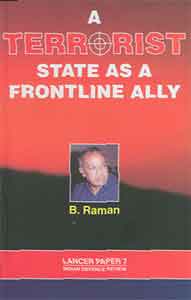At a religious congregation held at the Binori mosque in Karachi on February 4, 2000, it was Maulana Mohammed Yousuf Ludhianvi, who was subsequently assassinated, and Mufti Shamzai, who together announced the formation of the JEM headed by Azhar. Shamzai, who is the chairman of the Majlis-i-Taawun Islami Pakistan (Organisation for Islamic Cooperation), said that the new jehadi organisation came into existence as a result of the decision of the Ulema, who would be patronising it with the sole purpose of organising the Mujahideen who had been forced out of various organisations.
He added: “Our objectives are limited to responding effectively to the Indian repression and extending support to the Kashmiri Mujahideen in their struggle against the Indian yoke. We will have no concern whatsoever with politics in Pakistan. We are loyal to Pakistan, its government and its people.”
Writing in the Friday Times (August 18-24, 2000), Khalid Ahmed, the well-known Pakistani analyst, said:
 “In 1996, Harkat-ul-Ansar was a powerful Deobandi militia fighting in Held Kashmir. Its activities were so violent that the US declared it (in October 1997) a terrorist organisation. Thereafter, a split occurred in it and the two factions that emerged abandoned the old name.“Harkat-ul-Mujahideen under Fazlur Rehman Khalil emerged as a big organisation, while Harkat-ul-Jehad-al-Islami, led by Saifullah Akhtar, failed to widen its influence. One reason was the involvement of Saifullah Akhtar in the unsuccessful rebellion by a section of army officers led by Major General Zaheer-ul-Islam Abbasi and Major Mustansir Billah in 1995. Saifullah Akhtar saved himself by turning state witness.
“In 1996, Harkat-ul-Ansar was a powerful Deobandi militia fighting in Held Kashmir. Its activities were so violent that the US declared it (in October 1997) a terrorist organisation. Thereafter, a split occurred in it and the two factions that emerged abandoned the old name.“Harkat-ul-Mujahideen under Fazlur Rehman Khalil emerged as a big organisation, while Harkat-ul-Jehad-al-Islami, led by Saifullah Akhtar, failed to widen its influence. One reason was the involvement of Saifullah Akhtar in the unsuccessful rebellion by a section of army officers led by Major General Zaheer-ul-Islam Abbasi and Major Mustansir Billah in 1995. Saifullah Akhtar saved himself by turning state witness.
“The Harkat-ul-Mujahideen formally announced itself as a new organisation in June 1996 in Muzaffarabad. In January 2000, Masood Azhar of Harkat-ul-Mujahideen was sprung from an Indian jail after the Kathmandu hijack. Masood Azhar had gone into India through ‘proper channels’, as a journalist endorsed by Islamabad (that is, the ISI). He was a follower of Maulana Haq Nawaz Jhangvi, the founder of the anti-Iran and anti-Shia organisation Sipah-e-Sahaba, who was killed in 1990.
Their Deobandi connection with Mullah Omar, the Amir of Afghanistan, strengthened their presence in Pakistan, especially in Karachi where Binori Masjid emerged as the big centre of the Pakistani Taliban.
“After his release, Masood Azhar wished to revive the legacy of his master. By this time the Harkat had become a major Deobandi organisation in Pakistan. Its main strength remained the militants of Punjab who not long ago had been the militants of Sipah-e-Sahaba.
“His return, therefore, caused an upheaval which climaxed in a grand split in the Harkat. The split was soon followed by the assassination of Maulana Yusuf Ludhianvi, a key figure in the Oeobandi movement because of his status as a spiritual guide to two important Oeobandi leaders, his Khalifas: Maulana Fazlur Rehman of JUI and Maulana Azam Tariq of Sipah-e-Sahaba.
“Their Deobandi connection with Mullah Omar, the Amir of Afghanistan, strengthened their presence in Pakistan, especially in Karachi where Binori Masjid emerged as the big centre of the Pakistani Taliban. The Binori Town complex of the Oeobandi seminary was headed by Mufti Nizamuddin Shamzai who was also a member of the Majlis-i-Shoora of JUI under Maulana Fazlur Rehman.
“The split in Harkat-ul-Mujahideen was caused by the militants in Punjab. Masood Azhar and his Punjabi following isolated the Harkat leader Fazlur Rehman Khalil. The formation of Jaish-e-Mohammed as a new organisation was announced, but Masood Azhar and Fazlur Rehman Khalil began to fight over the Harkat assets.
In Pakista, the jaish emerged as the more radical and more sectarian part of the Harkat because of its Sipah-e-Sahaba background.
“On March 19, 2000, the two submitted to a hakam (arbitration) of their elders. Harkat was represented by Muhammed Farooq Kashmiri and Jaish was represented by Maulana Abdul Jabbar (a key figure in the Kathmandu hijack) on the pledge given that they would abide by the hakam. The verdict was given by three elders: Mufti Rasheed Ahmed of Zarb-i-Momin Jihadi militia, Mufti Nizamuddin Shamzai of the Binori Town complex and Dr Sher Ali Shah of Waziristan. The decision was that all offices of the Harkat, occupied by Jaish in Punjab, would be returned to the Harkat, which in turn would pay the Jaish Rs 40 lakh as its share of the division of assets.
“The implementation of the hakam, however, was not so smooth. The vehicles and offices returned by Jaish to Harkat were in such bad repair that Harkat refused to accept them and thus also refused to pay the stipulated 40 lakhs. Meanwhile, in the field, the splinter groups fell upon each other. At Ath Maqam in Kashmir, members of Harkat suffered serious injuries in an ambush by the Jaish (Daily Insaf, May 30, 2000).




